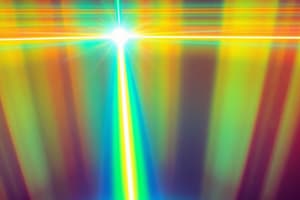Podcast
Questions and Answers
What is laser beam machining (LBM) and how does it remove material from surfaces?
What is laser beam machining (LBM) and how does it remove material from surfaces?
Laser beam machining is a form of machining that uses heat directed from a laser beam. It uses thermal energy to remove material from metallic or nonmetallic surfaces by heating, melting, and vaporizing the material due to the impinge of photons.
What type of materials is laser beam machining best suited for?
What type of materials is laser beam machining best suited for?
Laser beam machining is best suited for brittle materials with low conductivity, but can be used on most materials.
How can laser beam machining be used on glass without melting the surface?
How can laser beam machining be used on glass without melting the surface?
With photosensitive glass, the laser alters the chemical structure of the glass allowing it to be selectively etched. The glass is also referred to as photomachinable glass.
What advantage does photomachinable glass have in biological applications?
What advantage does photomachinable glass have in biological applications?
What are the different types of lasers mentioned in the text?
What are the different types of lasers mentioned in the text?
Flashcards are hidden until you start studying
Study Notes
Laser Beam Machining (LBM)
- LBM is a non-traditional machining process that uses a high-powered laser beam to remove material from surfaces
- The laser beam is focused onto a small area, causing the material to vaporize or melt, and the molten material is then blown away by a gas jet
Suitable Materials for LBM
- LBM is best suited for materials with high accuracy and precision requirements, such as micro-electromechanical systems (MEMS), semiconductors, and medical devices
- It is also used for materials that are difficult to machine using traditional methods, such as ceramics, glass, and hard metals
LBM on Glass
- Laser beam machining can be used on glass without melting the surface by using a short-pulse laser that vaporizes the material quickly, reducing heat buildup
- This process is known as "cold ablation" and allows for precise machining of glass surfaces
Photomachinable Glass in Biological Applications
- Photomachinable glass has an advantage in biological applications due to its ability to be precision-machined into complex structures and patterns, making it ideal for biomedical devices and implants
Types of Lasers
- Several types of lasers are used in LBM, including: • Excimer lasers, which are commonly used for micromachining and precision drilling • Nd:YAG lasers, which are used for drilling and cutting of thicker materials • CO2 lasers, which are used for cutting and machining of non-metallic materials
Studying That Suits You
Use AI to generate personalized quizzes and flashcards to suit your learning preferences.




